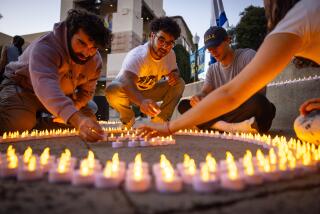Documentary : Jerusalem Tunnel Leads to Root of Mideast’s Ancient Conflict : Western Wall tour is journey into politics of spiritual real estate.
- Share via
JERUSALEM — The tour began in an ancient donkey stable, out a rear arch marked “Secret Passageway” and down an ancient stairway 800 years into the past.
It continued down another shaft, 2,000 years deeper beneath the Holy City, along 400 yards of the most sacred stones of Judaism and, finally, into a tiny chamber that is said to be the closest any mortal can now come to what Jews know as the Holy of Holies--”the navel of the world,” the spiritual center of the Jews and, a guide explained, the foundation stone of life itself.
“This is the Gateway to the Heavens,” American-born Tehilla Rapps told our small tour group as she led us into the tiny chamber deep inside the Earth and to a small archway that was sealed just two decades ago to prevent men from killing each other down here. The archway leads to perhaps the most disputed rock on Earth and, the guide explained, to another chamber on the other side that was the original home of the lost Ark of the Covenant, home of the ancient Scriptures of the Jewish faith.
“Wherever we live in the world, whether it’s America, England, South Africa, Canada, China, a Jew always prays in this direction--right over here to this gateway,” Rapps said.
There’s just one problem.
On the other side of the filled-in archway and those sacred stones of the Western Wall lies one of the holiest sites of Islam, as well: the Dome of the Rock and the nearby Al Aqsa mosques, which now rest on the so-called Temple Mount--site of the Jewish temple first built by King Solomon nearly 3,000 years ago and then rebuilt after being destroyed by the Babylonians.
Referring to the Israeli capture of Jerusalem’s walled Old City in the 1967 Arab-Israeli War, Rapps recounted: “After 1967, you see, Rabbi Getz, who is called the Rabbi of the Western Wall and was a leading figure in this whole excavation, was able to go through this tunnel and actually get to the steps that would lead up to the area of the Holy of Holies (where the Ark of the Covenant once rested), which is today the Dome of the Rock.
“Then, there was some argument here. The Muslims were on the other side, and Rabbi Getz was coming with his people on this side. And I’ve heard--there were stories--that there were Arabs who came down with knives, who were very concerned.
“The immediate fear, of course, of any excavations going on down here is that we’re going to go over there, we’re going to take over the Temple Mount, we’re going to tear down the mosque and we’re going to rebuild a Third Temple. And that’s why the Ministry of Religious Affairs is conducting this excavation. Because it’s not an archeological site. It’s the holy site for the Jews--our holiest site.”
Such is the politics of spiritual real estate and cosmic archeology in the seemingly unending Middle East conflict. For a reporter, the journey underneath the Old City of Jerusalem represented a quest for perspective and insight into the roots of Israel’s conflict with its Arab neighbors--antagonists now gathered in Washington at Middle East peace talks brokered by the United States.
It was only through the Tunnel Tour of Jerusalem, Rapps had told me a few days before, that an outsider could begin to understand the depth, the fervor, the commitment and the intransigence of so many Israelis in the prolonged and volatile political controversies over the future of the Golan Heights, the West Bank and the Gaza Strip; over the fate of some 1.5 million Palestinians living in territory that Israel has held since 1967; over future ownership of Jerusalem itself.
The once-a-week Tunnel Tour--available only by special arrangement--is “an amazing, amazing chance to really see what all of this is about,” Rapps said. The tour was scheduled for the following Friday--the Islamic holy day.
The entrance to the tour and the archeological dig that made it possible was a modern, glass doorway just 100 feet or so away from the 2,000-year-old Western Wall, where hundreds of thousands of Jews come each year to pray, to weep and to recall the splendor of the temples that once lay behind it.
“There’s a lot more to that wall than one might think,” said Rapps, explaining that the visible section is just a tiny piece of the entire 450-yard-long wall that King Herod built to protect the western side of his Second Temple.
“And nobody knew that the entire wall was still standing until after 1967, when the Ministry of Religious Affairs began an excavation here. They came to this tunnel where you’re standing, they walked through the secret passageway that we’re going to walk through and they began to dig. . . . They dug out a tunnel that you’re going to walk through, and they disclosed that the entire wall is actually still standing.
“So why can’t we see it? Because homes have been built onto the wall using the wall as one of the walls of the homes. . . . It is what is called today the Muslim Quarter.”
And that was the recurring theme throughout the tour--that the Jews have come not to conquer but to reclaim what they lost 2,000 years ago. An underground slide show, set to flutes and violins, was even more emphatic: “For the Jews . . . it was just a matter of waiting 2,000 years, and return they did. . . . And when the pioneers went up to Jerusalem and stood before these stones, they suddenly found themselves touching the very events that had taken place here thousands of years before. . . . And the more we reveal the Kotel (the Western Wall), the more we realize that the building of our future stands in the foundation of our past.”
There was, of course, also archeology and history along the way.
Rapps later explained that King Solomon had selected the site for his splendid First Temple over the very rock on which Abraham stood when God first spoke to him--an event she narrated in detail. (She did not mention that it is written in the Islamic holy book, the Koran, that Prophet Mohammed rose up to heaven from the same rock.)
And the young guide recounted how Solomon’s temple, destroyed by the Babylonians in the 6th Century BC, was rebuilt by a guilt-ridden King Herod, for whom our guide had little praise outside of his building skills.
“He was a Roman puppet,” she said of the ancient king who built the entire Western Wall. “And he was very paranoid. He even killed his own wife. He killed his own children. He was crazy.” A sage told the king he would be forgiven for all only if he rebuilt Solomon’s temple--an extraordinary feat that Herod accomplished in just three years using stones that weighed up to 600 tons each.
The tour concluded in a cavernous, underground hall that is the tour’s centerpiece. There the Ministry of Religious Affairs has installed a large, intricately carved, motorized wooden replica of the original temple.
“Now, we’re in front of this beautiful, beautiful building,” Rapps told her charges. “How did we go from this beautiful building (she pointed to the model) to this (she pointed to the crumbling remnants of the underground wall)?” She then read a Hebrew prayer--”God, you have abandoned me. You have forgotten me.” And she explained how the Second Temple of King Herod was destroyed.
“You know that many, many groups came and conquered and overran this country. The Romans. The Byzantines. The Persians. The Arabs. The Crusaders. The Mamelukes. The British. And finally, we have returned. But, you can see here how homes have been built onto the wall. And this is what is currently known as the Muslim section.”
Then, suddenly, the model moved. The entire Muslim Quarter and its thousands of homes disappeared, replaced by terraced farms and trees, in a dramatic finale to the tour. “And now,” Rapps said, “we return to the dream of what we hope will one day be here--the return of this temple once again to all its glory and all its splendor.”
Afterward I asked Rapps whether the Israeli government--indeed, the Jewish people themselves--actually was committed to confiscating the Muslim homes and shrines and rebuilding the temple--an act that some argue would set back peace talks several centuries.
“Look, everybody hopes that the temple will be rebuilt,” she replied. “But the approach of everybody is, that’s not what we’re about now. What we’re about now is returning to the land and about resettling the land and gathering the Jews from all over the world in one place.”
Reminded that the Muslims also have centuries of spiritualism invested in the same site, Rapps said: “Well, I’ll tell you. There is a spiritual energy here that we share. And we both believe in one God. This house should be a house for all nations. That’s what we pray for. For all religions. One building that will be the focus of all spiritual energy. The center of the world.”
Nicosia bureau chief Fineman was recently on assignment in Jerusalem.
More to Read
Sign up for The Wild
We’ll help you find the best places to hike, bike and run, as well as the perfect silent spots for meditation and yoga.
You may occasionally receive promotional content from the Los Angeles Times.






